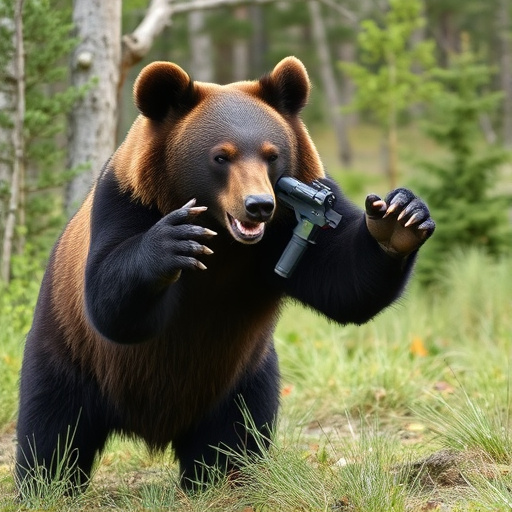In many national parks with high bear populations, carrying bear spray is legally required for visitor safety. Understanding specific bear spray laws, varying by region, is crucial for a safe and enjoyable visit. Selection should consider can size, nozzle type, ingredient strength, and intended use, while practicing usage techniques enhances preparedness during encounters. Always follow local regulations, maintain distance from bears, and aim for their face and eyes if an attack is imminent. Responsible use significantly improves safety in wilderness areas.
“Discover the power of outdoor defense with bear attack prevention spray—a vital tool for adventurers and nature enthusiasts. This comprehensive guide explores the ins and outs of bear spray, from its effectiveness against aggressive bears to navigating crucial legal aspects in national parks. Learn about the unique properties of this life-saving product and how to choose the best fit for your outdoor needs. Understand the essential safety tips to ensure a secure and enjoyable experience while exploring nature’s realms.”
- Understanding Bear Spray: What It Is and How It Works
- Bear Spray Laws in National Parks: A Comprehensive Overview
- Choosing the Right Bear Spray for Your Needs
- Safety Tips for Using Bear Spray in Outdoor Adventures
Understanding Bear Spray: What It Is and How It Works
Bear spray, also known as bear defense spray, is a specialized pepper spray designed to deter and defend against potential bear attacks. It’s a crucial tool for outdoor enthusiasts, hikers, and campers navigating areas with high bear populations, especially within National Parks where bear spray laws are in place for visitor safety. This potent spray contains capsaicin, the active ingredient found in chili peppers, which irritates the eyes, nose, throat, and lungs of bears, temporarily disabling them and giving users precious time to escape or defend themselves.
Unlike traditional pepper spray designed for human self-defense, bear spray is formulated to reach and affect a bear’s sensitive facial areas from a safe distance, typically between 20 to 30 feet (6 to 9 meters). The effectiveness of bear spray relies on proper usage techniques, including aiming for the bear’s face and eyes, and following up with a loud, assertive voice command. Understanding these dynamics is key when considering bear spray as a preventive measure in National Parks, where bears are often habituated to human presence and can react aggressively if startled or threatened.
Bear Spray Laws in National Parks: A Comprehensive Overview
In many national parks across the globe, carrying bear spray is not just recommended but often mandated by law. These regulations are in place to ensure visitor safety and minimize conflicts with bears. Each park has its own specific rules regarding bear spray, including allowed types, minimum strengths, and storage requirements. Understanding these Bear Spray Laws in National Parks is crucial for anyone planning a visit, as they vary widely from region to region.
For instance, some parks may require all visitors to carry bear spray, while others might only mandate it for certain trails or during specific seasons. There are also guidelines on how and where the spray should be stored, often in easily accessible yet secure locations, to ensure its availability when needed. Familiarizing oneself with these laws can greatly enhance a visitor’s experience by fostering a sense of security and preparedness in bear country.
Choosing the Right Bear Spray for Your Needs
When selecting bear spray, understanding your specific needs and local regulations is paramount. Different environments call for distinct levels of protection—from lightweight, travel-sized sprays suitable for hiking trails in national parks, to heavier duty options designed for extended outdoor activities or areas with higher bear activity. Bear spray laws vary across regions, so it’s crucial to check the regulations before purchasing. National parks, for instance, often have specific guidelines regarding the type and quantity of bear spray allowed.
Factors like can size, nozzle type, and spray pattern should be considered alongside ingredient strength and effectiveness. Some sprays are designed for close encounters, while others offer a longer reach. Always review safety instructions and practice proper usage techniques to ensure the spray will deploy effectively when needed.
Safety Tips for Using Bear Spray in Outdoor Adventures
When embarking on outdoor adventures in areas known for bear populations, such as national parks, always carry bear spray as a crucial layer of protection. Before setting out, familiarize yourself with local regulations regarding bear spray possession and usage. Different regions have varying laws, so understanding these rules is essential to ensure compliance and enhance safety.
For optimal effectiveness, bear spray should be used correctly. Practice the spray technique in advance, ensuring you can deploy it quickly and accurately when needed. Maintain a safe distance from bears, typically 100 yards or more, before applying spray. In case of an encounter, aim for the bear’s face and eyes, creating a barrier that can stop an attack. Remember, early detection and responsible usage of bear spray can significantly reduce potential risks during outdoor pursuits in national parks and other wilderness areas.
In conclusion, understanding bear spray, its application, and the underlying Bear Spray Laws in National Parks is an essential component of any outdoor adventure. The right choice and safe usage of this deterrent can significantly enhance your safety in bear country. Always stay informed about local regulations and follow expert advice for a memorable and secure outdoor experience.
